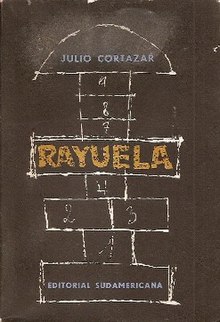Rayuela

First edition
|
|
| Author | Julio Cortázar |
|---|---|
| Original title | Rayuela |
| Translator | Gregory Rabassa |
| Country | Argentina |
| Language | Spanish |
| Publisher | Pantheon (US) |
|
Publication date
|
28 June 1963 |
|
Published in English
|
1966 |
| Media type | Print (paperback) |
| Pages | 576 |
| OCLC | 14412231 |
| 863 19 | |
| LC Class | PQ7797.C7145 R313 1987 |
Hopscotch (Spanish: Rayuela) is a novel by Argentine writer Julio Cortázar. Written in Paris, it was published in Spanish in 1963 and in English in 1966. For the first U.S. edition, translator Gregory Rabassa split the inaugural National Book Award in the translation category.
Hopscotch is a stream-of-consciousness novel which can be read according to two different sequences of chapters. This novel is often referred to as a counter-novel, as it was by Cortázar himself.
Written in an episodic, snapshot manner, the novel has 155 chapters, the last 99 designated as "expendable." Some of these "expendable" chapters fill in gaps that occur in the main storyline, while others add information about the characters or record the aesthetic or literary speculations of a writer named Morelli who makes a brief appearance in the narrative. Some of the "expendable" chapters at first seem like random musings, but upon closer inspection solve questions that arise during the reading of the first two parts of the book.
An author's note suggests that the book would best be read in one of two possible ways, either progressively from chapters 1 to 56 or by "hopscotching" through the entire set of 155 chapters according to a "Table of Instructions" designated by the author. Cortázar also leaves the reader the option of choosing a unique path through the narrative.
Several narrative techniques are employed throughout the book, and frequently overlap, including first person, third person, and a kind of stream-of-consciousness. Traditional spelling and grammatical rules are often bent and sometimes broken outright.
The first 36 chapters of the novel in numerical order are grouped under the heading "From the Other Side." They provide an account of the life of Horacio Oliveira, an Argentine intellectual. He experiences life in Paris in the 1950s. The other characters consist of La Maga and a band of bohemian intellectuals who call themselves the Serpent Club.
The story opens with Horacio searching the bridges of Paris for La Maga, who has disappeared. The story progresses in a non-linear order. Scenes with the Serpent Club, which convenes in the evening to drink, listen to jazz music, and engage in arguments about art and life alternate with descriptions of Oliveira's solitary jaunts through the city.
...
Wikipedia
